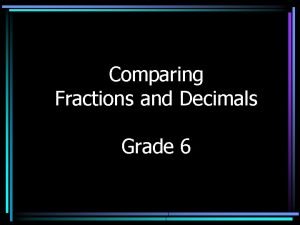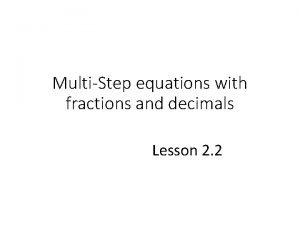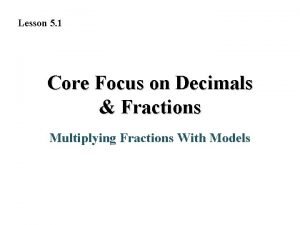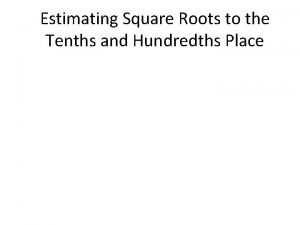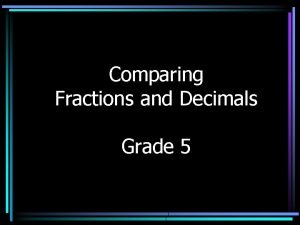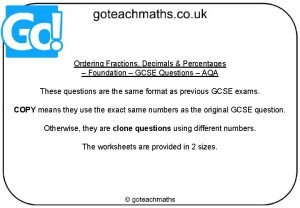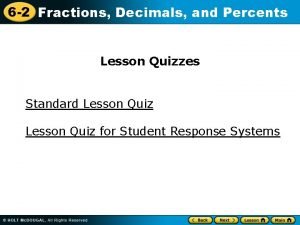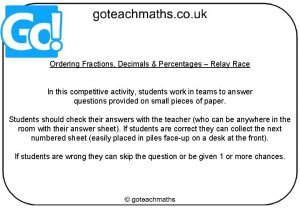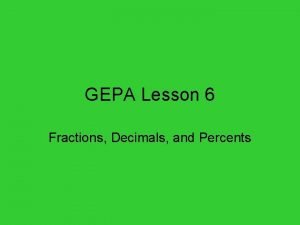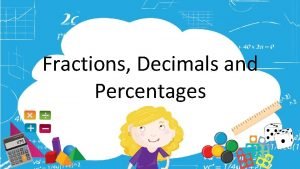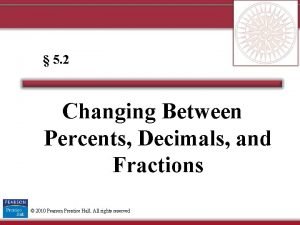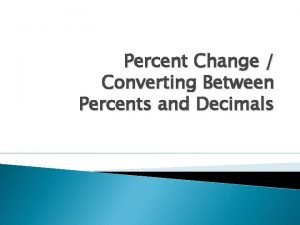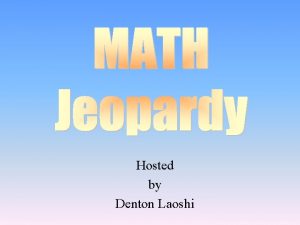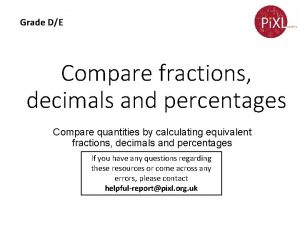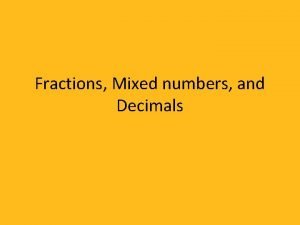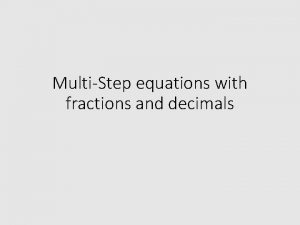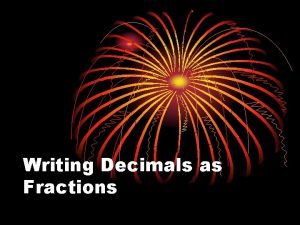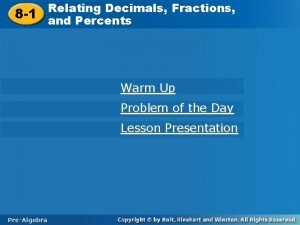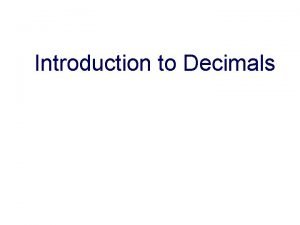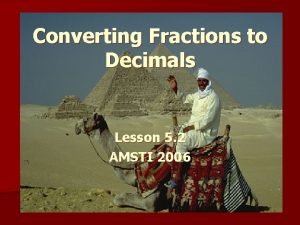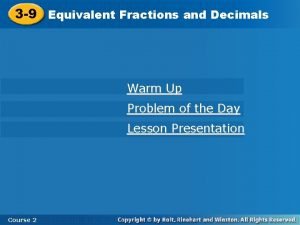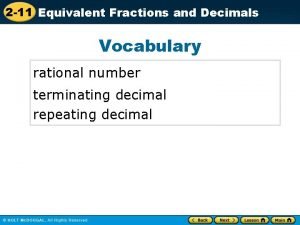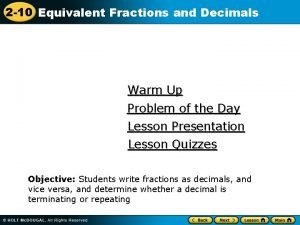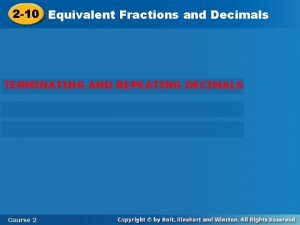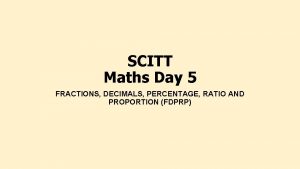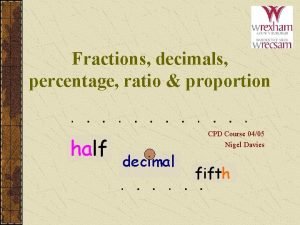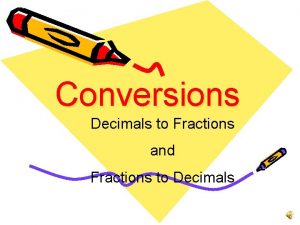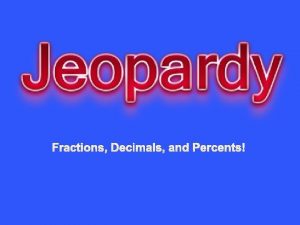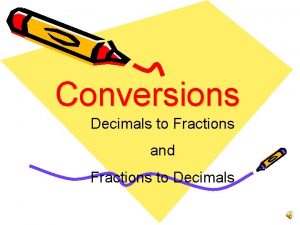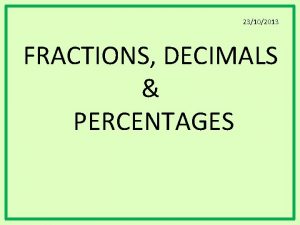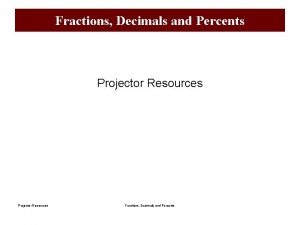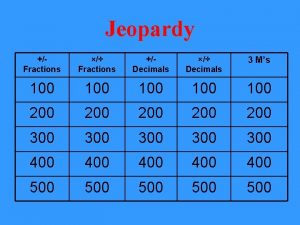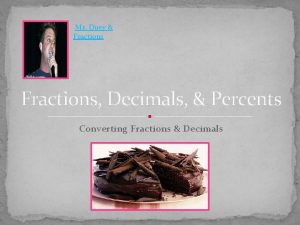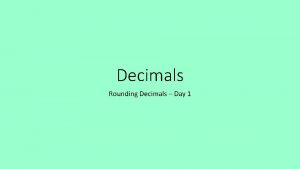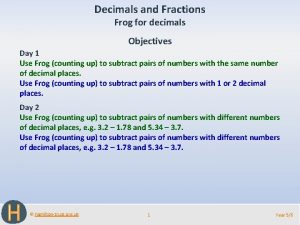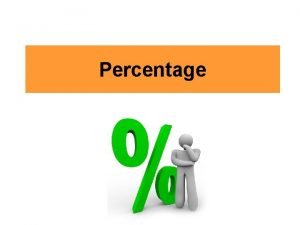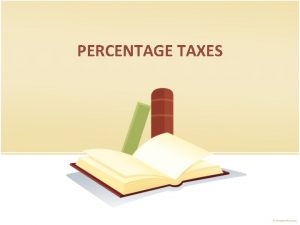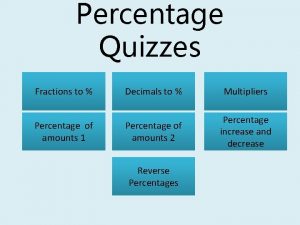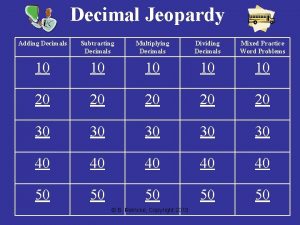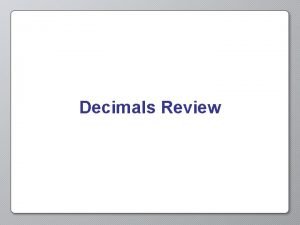SCITT Day 10 Fractions decimals percentage ratio and








































- Slides: 40

SCITT Day 10 Fractions, decimals, percentage, ratio and probability

Summer Term Visits by Gill End of day 9. 6 Tash & Jess Northwick Park Primary School Hockley 10. 6 Peter & Martin Brightlingsea Junior School & St Johns Colch 11. 6 Roxie & Amy Northwick Park Primary School Basildon 20. 6 Danielle & Tamsin Takeley P 23. 6 Sarah & Clare Bentfield & Henham+Ugley 24. 6 Laura Cold Norton Thurrock 25. 6 Tom & Adam Stebbing St Peters 26. 6 Katie Newnham Crofy Herts 27. 6 Candice & Louise Lyons Hall & White Notley 30. 6 Emma & Stefanie Copford & Heathlands Colch 1. 7 Rebecca & Jo Highwood & Moulsham Inf Chelmsfd 2. 7 Richard Water Lane Harlow 9. 7 Lucy & Tacita Felsted & Boreham Gt Easton & Thaxted 10. 7 Dan & Stacey

We will… • understand the relationship between fraction, decimal, percentage and ratio; • explore probability as an extension of activities with predicting and testing; • discuss homework and other associated learning outside the classroom.

Associated issues for teaching • Extending the number line to include all real numbers. • Consider the role of mathematical games in the classroom. • Finding relevant homework activities. • Probability as “making decisions”, a key life skill. • & CALCUALTORS!

Sessions 1. Homework and FDPRP 2. Calculators in the Primary Classroom 3. Games to consolidate learning 4. What / where next? Identifying your next steps for mathematics learning and teaching.

Homework • What is your school policy for homework? • What have you seen as examples of homework? • How COULD homework be used? • What could maths in the home look like? • What role could games play at different ages?

Issues to consider 1. Manageability 2. Parents – info and support 3. Timings? 4. Variety 5. Use of existing scheme/books to provide materials. 6. Use of games? 7. Investigations? 8. Staff meeting provision… 9. Open evening/meeting?

Fractions Identifying the language, models, images and experiences children need in order to have an understanding of fractions; Considering the different concepts involved in fractions; Reviewing a range of materials which can support the learning of fractions.

Mental Oral Starters • What could you learn about a pupil’s understanding during these activities?

This is half the house. Can you make the whole?

Halving • Create an array of counters 3 x 4. • Can you put a line through the array to show half? • How many different ways can you find? • Choose another array, try placing 1, 2, 3…. lines. Talk about what’s happening! • (Use language of x, ÷ or fractions)

What fractions can you make with 1, 8, 2 and 4? • Are all the fractions different? • Choose a way / some ways of sorting the fractions into groups. • Explain your thinking.

How might ¾ be represented? • With your partner, generate as many different representations of ¾ as you can. • Draw each ‘ ¾ ’ on a different post-it. • Compare your representations with others.

Part – Whole Fractional Models • Area: The whole is split in to equal parts. • Linear: The size of the fraction is modeled by the length of the line. 0 ¼ ½ ¾ 1 • Set: The set of objects is the whole and we split in to equal subsets. ** **

Fractions Should be Thought of as… • Part of a whole (proportion) • A relationship between two separate things (ratio) • A division operation ÷

1/5 of 2 4 x 1/10 ½ of 80% 40% 2 x 1/5 8/20 2/5 4 ÷ 10 4/10 2÷ 5 0. 400 4 x 0. 1

Percentages • How would you express 7/8 as a percentage? • How would you express 85% as a fraction?

Would you Prefer to Calculate using Fractions, Decimals or Percentages? 1. 0. 5 x 40 2. 145% of 1000 3. Which is larger, 8/10 or 6/7?

Progression in Understanding Fractions are… 1. Part of whole – region split in two or more parts 2. Part of the set 3. Numbers on the number line 4. An operator (division) 5. A ratio Where do your learners fit into this progression?

Misconceptions • Fractions are less than 1 • The bigger the denominator the bigger the size of the fraction • The smallest number always goes on top • If I split any shape into 2 pieces, they are two halves • ½ = 2/3 = ¾ = 4/5 … • 2/3 + 2/3 = 4/6 • represents 1/3

Defining terms As a Fraction • “¼ of the tiles are green” As a Decimal • “ 0. 25 of the tiles are green” As a Percentage • “ 25% of the tiles are green”

Defining terms As a Proportion • “One in every four tiles is green” As a Ratio • “The ratio of green tiles to red tiles is 4 to 12 or 1 to 3” • or “ 1 green for every 3 red”

Proportion and Ratio

Proportion and Ratio

Proportion and Ratio

Games to support FDPRP • 0 – 10 line: Decimal Digit cards • Calculator Fish • Domino Fractus!

Probability Scale What is the probability of… Flipping a coin and it landing on ‘heads’?

Probability Scale What is the probability of… Rolling a ‘ 5’ on a normal dice?

Probability Scale What is the probability of… Choosing a Jack from a pack of cards?

Probability Scale What is the probability of… Picking a red counter from a bag with 3 blues, 2 yellows and 4 red counters?

Number Spinners ITP • …it’s on the disk!

Games for thinking Target 24 – in Pairs • Use any numbers from 1 to 10 (once and once only) to add cumulatively. • The player that makes ‘ 24’ wins. Ideas for adaptations?

Games for thinking Turn over 2 digit cards. Use any maths you know to make as many ‘solutions’ as you can…e. g. Player 1 turns over 2 and 5… Cover: • 2 and 5 • 25 and 52 (Place value) • 3, 7, 10 (using 3 of the 4 operations) • 2 5 (or 2 x 2 x 2 = 32) … 2(5 is covered!) Adaptations?

Calculator digits

Getting to know your calculator • How does the memory work? • How does the constant facility work?

Calculators as a teaching tool • • Press the following sequence of buttons 5 + + = 0 Now press = 3 times What happens? What if I press it 3 times more? How many presses to get to 50? What about - - or x x?

Try this • • 9 + += Now enter 12 and ask the question “ What number is 9 more than 12? ” Press =

Constant function • Some are: – Start no + + step size = = = • Others are – Step size + + start number = = = – What have you got? – Try 24 ++ 5 =====

Mathematical Games Share your games… – What was the intended learning objective? – Does the game support that learning intention? – How could the game be adapted?

Did we…? • understand the relationship between fraction, decimal, percentage and ratio? • explore probability as an extension of activities with predicting and testing? • discuss homework and other associated learning outside the classroom? • Extending the number line to include all real numbers? • Consider the role of mathematical games in the classroom? • Finding relevant homework activities? • Probability as “making decisions”, a key life skill? • & CALCULATORS?
 Day 1 day 2 day 3 day 4
Day 1 day 2 day 3 day 4 How to compare decimals and fractions
How to compare decimals and fractions How to multiply fractions with decimals
How to multiply fractions with decimals Compare
Compare Ordering fractions and decimals
Ordering fractions and decimals How to distribute fractions
How to distribute fractions Lesson 5 decimals and fractions
Lesson 5 decimals and fractions Hundredths square
Hundredths square Changing decimals to fractions and vice versa
Changing decimals to fractions and vice versa Channel 5 2005
Channel 5 2005 Fractions decimals and percentages gcse
Fractions decimals and percentages gcse Christmas fractions
Christmas fractions 6-2 relate fractions decimals and percents
6-2 relate fractions decimals and percents Greatest to least fraction
Greatest to least fraction Lesson 6-2 fractions, decimals, and percents answers
Lesson 6-2 fractions, decimals, and percents answers Lesson 6-2 fractions, decimals, and percents answers
Lesson 6-2 fractions, decimals, and percents answers Decimals in everyday life
Decimals in everyday life Percents to decimals
Percents to decimals Converting between percents decimals and fractions
Converting between percents decimals and fractions Fractions decimals and percents calculator
Fractions decimals and percents calculator Compare fractions decimals and percentages
Compare fractions decimals and percentages What is 75/4 as a mixed number
What is 75/4 as a mixed number Multi step equations with fractions
Multi step equations with fractions What is the decimal representation of 27/100
What is the decimal representation of 27/100 Relating decimals to fractions
Relating decimals to fractions Questions on recurring decimals
Questions on recurring decimals 98/1000 as a decimal
98/1000 as a decimal Converting fractions to decimals lesson
Converting fractions to decimals lesson Writing fractions as decimals
Writing fractions as decimals Writing fractions as decimals
Writing fractions as decimals What is 2/10 equivalent to
What is 2/10 equivalent to Writing fractions as decimals
Writing fractions as decimals Recurring decimal
Recurring decimal Changing fractions to decimals
Changing fractions to decimals Improper fractions to decimals
Improper fractions to decimals Fractions amp; decimals quick quizzes ages 7 9 download
Fractions amp; decimals quick quizzes ages 7 9 download How to find a fraction of a number
How to find a fraction of a number Day 1 day 2 day 817
Day 1 day 2 day 817 Essex primary scitt
Essex primary scitt Pcp scitt
Pcp scitt Scitt moir
Scitt moir

